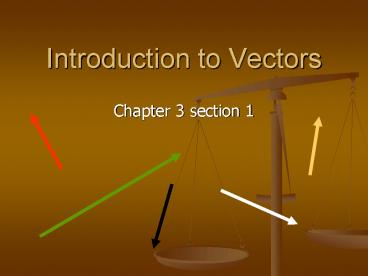Introduction to Vectors - PowerPoint PPT Presentation
1 / 15
Title:
Introduction to Vectors
Description:
Introduction to Vectors Chapter 3 section 1 Scalar Quantity Scalar A quantity that can be completely specified by its magnitude, but NO direction. – PowerPoint PPT presentation
Number of Views:450
Avg rating:3.0/5.0
Title: Introduction to Vectors
1
Introduction to Vectors
- Chapter 3 section 1
2
Scalar Quantity
- Scalar A quantity that can be completely
specified by its magnitude, but NO direction. - Examples
- Speed
- Distance
- Volume
- Energy
- Time
- Mass
3
Vector Quantity
- Vector A quantity that can be described by its
magnitude AND its direction. - Examples
- Displacement
- Velocity
- Acceleration
- Force
- Momentum
4
Vectors and Scalars in the Book
- Vectors quantities are indicated in Boldface by
their variable. - v 30 m/s
- Scalars quantities are indicated in italics by
their variable. - t 3.2 s
5
Vector Diagrams
- In diagrams, vectors are shown as arrows that
point the direction of its magnitude. - Length of arrow Magnitude of the vector
- Direction of arrow Path of vector
v 30 mi/hr
v 60 mi/hr
6
Resultant
- Resultant A vector representing the sum of two
or more vectors. - When adding vectors, they must have the same
units and describe similar quantities. - Example
- The sum of the vectors must all be velocity and
must be in units of m/s.
7
Vector Addition in 1-Dimension
A5m
R7m
B2m
ABR 5m 2m 7m
A5m
B3m
R2m
ABR 5m (-3m) 2m
8
Head-to-Tail Method
- To add two (or more) vectors together graphically
using the head-to-tail method you simply draw the
first vector and then draw the second vector with
its tail at the head of the first vector. - If there are more vectors to be added draw each
one with its tail at the head of the preceding
one. The sum or resultant is a vector drawn from
the tail of the first vector to the head of the
last vector. It does not matter in which order
you add them.
9
Vectors
The resultant always measures from where you
started to where you end at.
HEAD
TAIL
10
Cartesian Plane
90
0
180
270
11
Vector Angles
- When describing the direction of a vector, the
angle always starts at the 0 degrees on the
x-axis and moves counter-clockwise to reference
the direction of the vector.
?300
?45
?105
12
Properties of Vectors
- Vectors can be moved parallel to themselves in a
diagram, as long as the magnitude stays the same. - The horizontal vector is moved and doesnt
change the problem as long as the magnitude
doesnt change and it remains parallel to its
original position.
13
Properties of Vectors
- 2. Vectors can be added in any direction.
- Ex ABCDE Resultant
- BADCE Resultant
E
E
Resultant
Resultant
C
D
D
C
A
B
B
A
14
Properties of Vectors
- 3. To subtract a vector, add its opposite
- A - B A (-B)
15
Properties of Vectors
- 4. Multiplying or dividing vectors by scalars
results in vectors. - 3 A 3A































